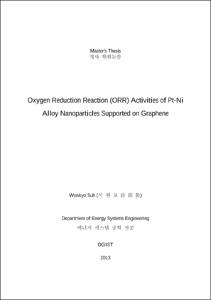Oxygen Reduction Reaction (ORR) Activities of Pt-Ni Alloy Nanoparticles Supported on Graphene
- Title
- Oxygen Reduction Reaction (ORR) Activities of Pt-Ni Alloy Nanoparticles Supported on Graphene
- Alternative Title
- 그라핀 지지체를 사용한 백금-니켈 나노입자 합금의 산소 환원 반응(ORR) 능력
- Author(s)
- Suh, Won Kyo
- DGIST Authors
- Suh, Won Kyo ; Shanmugam, Sangaraju
- Advisor
- Shanmugam, Sangaraju
- Co-Advisor(s)
- Han, Oc Hee
- Issued Date
- 2013
- Awarded Date
- 2013. 2
- Type
- Thesis
- Subject
- Fuel cells ; Graphene ; Pt-Ni alloy catalysts ; Oxygen reduction reaction (ORR) ; 연료전지 ; 그라핀 ; 백금-니켈 합금 촉매 ; 산소 환원 반응(ORR) 능력
- Abstract
-
Polymer electrolyte membrane fuel cell (PEMFC) has been studied widely due to its higher energy efficiency than a conventional internal combustion engine by generates electrical energy directly from chemical energy. However, the fuel cells faces lots of challenges to commercialization. Cost reduction and improvement of catalysts activities are two major problems impedes the commercialization. Since costly platinum has been used as a catalyst at both anode and cathode of fuel cells, it is required to decrease amounts of Pt. Alloying Pt with secondary transition metals such as Fe, Co, and Ni can reduce the amount of Pt and leading to the cost reduction. In terms of activities, not only Pt-M (M=Fe, Co, Ni, etc.) alloys but carbon support materials should be considered. Graphite materials such as Valcan carbon XC-72 (VXC) and carbon nanotubes (CNT) have been utilized as a carbon support materials for fuel cells. Moreover, since it discovered, graphene has been widely used as a support for electrocatalysts with different metal nanoparticles because of its specific features like high electro-conductivity, surface area and thermal stability.
In an attempt to develop low cost and highly active oxygen reduction reaction (ORR) catalysts, graphene supported Pt-Ni alloy catalyst was synthesized, and the electrochemical ORR performance was evaluated. Due to the ORR sluggish on cathode side plays an important role in fuel cells performance, it is necessary to improve the ORR activities of electrocatalysts. The ORR activity of Pt-Ni supported on graphene was compared with commercial Pt/C catalyst, and Pt-Ni alloy supported on other carbon support materials such as carbon black (VXC) and carbon nanotube (CNT). Among three different electrocatalysts, Pt-Ni alloy catalyst supported on graphene showed highest ORR activity. All Pt-Ni alloy catalysts were followed the direct 4 electron pathway. Among three catalysts, Pt-Ni/graphene catalyst was observed lowest hydrogen peroxide production. Moreover, Pt-Ni/graphene catalysts showed highest methanol resistance. Pt-Ni alloy catalysts were characterized using various physical-chemical techniques, such as scanning electron microscopy, transmission electron microscope, X-ray diffraction, and X-ray photoelectron spectroscopy. The electrocatalytic activity and stability of Pt-Ni alloy catalysts were studied using CV, LSV, RDE and RRDE techniques. Thus, developing Pt-Ni alloy supported on various carbon materials with desired properties of ORR activities will be discussed. ⓒ 2013 DGIST
- Table Of Contents
-
Chapter 1: Introduction 1
--
1.1. Forewords 1
--
1.2. Objectives of the work 3
--
1.3. Advantages & disadvantages of fuel cells 4
--
1.4. Fundamental principles of the fuel cells systems 6
--
1.5. Various types of fuel cells 9
--
1.6. Studies of carbon allotropes for fuel cell carbon support materials 13
--
1.7. Structure and characteristic of graphene 15
--
1.8. Oxygen reduction reaction (ORR) studies 18
--
1.8.1. Low temperature ORR mechanism 18
--
1.8.2. Oxygen reduction reaction on Pt catalyst surface 19
--
Chapter 2: Experimental 20
--
2.1. Chemicals 20
--
2.2. Synthesis of graphene 20
--
2.2.1. Preparation of graphene oxide 20
--
2.2.2. Chemical reduction of graphene oxide to graphene 21
--
2.3. Surface modification of carbon nanotube (CNT) 21
--
2.4. Preparation of Pt-Ni (1:1) (20 wt % metal loading) alloy catalysts supported on carbon black (Vulcan XC-72), CNT, and graphene 22
--
2.5. Characterization 22
--
2.5.1. Physical characterization 22
--
2.5.2. Elemental characterization 23
--
2.5.3. Electrode preparation and electrochemical measurement 23
--
Chapter 3: Results and Discussion 25
--
3.1. Morphologies and size distribution of Pt-Ni based electrocatalysts 25
--
3.2. Crystalline structure analysis of Pt-Ni based electrocatalysts 31
--
3.3. Chemical and electronic properties of Pt-Ni based electrocatalysts 34
--
3.4. Electrochemical studies of Pt-Ni based electrocatalysts 39
--
3.4.1. Electrochemical surface area 39
--
3.4.2. Oxygen reduction reaction activities of Pt-Ni based electrocatalysts 41
--
3.4.3. Methanol tolerance studies of Pt-Ni based electrocatalysts 46
--
3.4.4. Stability of Pt-Ni based electrocatalysts 49
--
Conclusions 51
--
Reference 53
--
국문 요약문 61
--
Acknowledgement 63
- URI
-
http://dgist.dcollection.net/jsp/common/DcLoOrgPer.jsp?sItemId=000002262497
http://hdl.handle.net/20.500.11750/1326
- Degree
- Master
- Department
- Energy Systems Engineering
- Publisher
- DGIST
- Related Researcher
-
-
Shanmugam, Sangaraju
- Research Interests Electrocatalysts for fuel cells; water splitting; metal-air batteries; Polymer electrolyte membranes for fuel cells; flow batteries; Hydrogen generation and utilization
-
- Files in This Item:
-
 기타 데이터 / 2.55 MB / Adobe PDF
download
기타 데이터 / 2.55 MB / Adobe PDF
download
- Appears in Collections:
- Department of Energy Science and Engineering Theses Master



